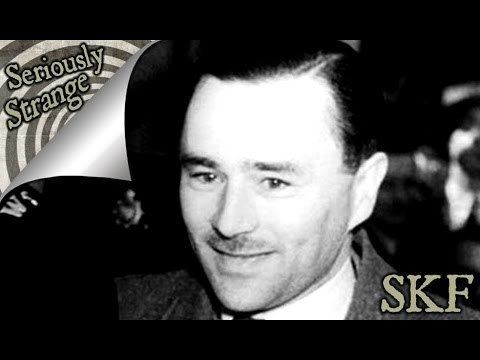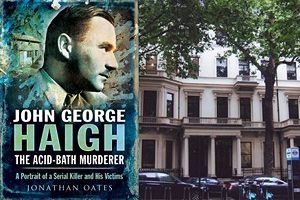Unmasking The Acid Bath Murderer: The Chilling Story Of John George Haigh
The Early Life and Deceptive Persona of a Fraudster
Born on July 24, 1909, in Lincolnshire, John George Haigh was raised in a strict, religious household that some speculate may have contributed to his later psychological complexities. From an early age, Haigh displayed a talent for deception and a distinct lack of empathy. Before he became known as the Acid Bath Murderer, Haigh was a career fraudster, constantly engaging in various schemes to enrich himself. His life was a revolving door of petty crimes, arrests, and brief stints in prison, each time emerging seemingly unchastened and ready to embark on a new venture of deceit. This pattern of criminal behavior laid the groundwork for the far more sinister path he would eventually take, showcasing a man who viewed others primarily as means to an end. His cunning and manipulative nature, honed through years of fraud, would later be applied to the ultimate crime: murder.The Genesis of a Macabre Method: The Acid Bath Murders
John George Haigh's reign of terror as the Acid Bath Murderer remains one of the most chilling chapters in British criminal history. What set Haigh apart from other killers was his utterly dispassionate and calculated approach to murder, combined with his unique and horrific method of body disposal. He gained notoriety in mid-20th century England for his use of sulphuric acid to dissolve his victims, earning him the grim moniker that would forever be attached to his name. Haigh's victims were often wealthy individuals, typically acquaintances or business associates, whom he lured with promises of lucrative deals or investments. Once he had their trust, and crucially, their assets, he would murder them. His initial victims, starting in the early 1940s, were the McSwans, a couple he had known for years. After killing them, he began his ghastly process of dissolving their bodies in barrels filled with concentrated sulphuric acid. He believed that by completely obliterating their remains, he could commit the "perfect" murder, leaving no forensic evidence behind. He meticulously planned his operations, renting small workshops or warehouses where he could carry out his gruesome work undisturbed. Inside these makeshift laboratories of death, he would place his victims' bodies into large 40-gallon drums, pouring in the corrosive acid and waiting for it to do its horrifying work. The process was slow and messy, leaving behind a sludge that he would then dispose of, often by pouring it down drains or scattering it in secluded areas. Haigh truly believed that if there was no body, there could be no murder conviction. This twisted logic fueled his escalating spree, leading him to commit at least five such "perfect" murders, though he was eventually convicted for six. His cold, clinical approach to dismemberment and dissolution painted a disturbing portrait of a sociopath who was utterly devoid of human compassion.The Unraveling: A Fatal Flaw in the "Perfect" Crime
Despite his meticulous efforts to erase all traces, Haigh's gruesome scheme eventually began to unravel. The turning point came in February of 1949, with the disappearance of Olive Durand-Deacon, a wealthy widow with whom Haigh had become acquainted. Haigh, ever the opportunist, had lured her to his workshop on Leopold Road in West Sussex under the pretense of showing her an invention. There, he shot her, stole her valuables, and proceeded with his usual method of acid disposal. However, Mrs. Durand-Deacon had a friend who was concerned about her disappearance and reported it to the police. Detective Inspector Donald Webb, leading the investigation, quickly connected Mrs. Durand-Deacon's disappearance to Haigh, who had been seen with her and had a history of fraud. The police, acting on a hunch and Haigh's suspicious behavior, raided a warehouse on Leopold Road in West Sussex, owned by John George Haigh. Inside, they found several 40-gallon drums and containers of acid, along with a .38 Webley revolver and a dry-cleaning receipt for Mrs. Durand-Deacon's Persian lamb coat. The most damning evidence, however, came from the sludge and residue found in the workshop. Forensic pathologist Dr. Keith Simpson meticulously examined the grim findings, discovering fragments of human bone, gallstones, and even a set of dentures, which were later identified as belonging to Mrs. Durand-Deacon. This was the irrefutable proof that Haigh's "perfect" murders were anything but. His belief that dissolving bodies left no trace was fundamentally flawed; while most soft tissues were gone, certain hard-to-dissolve elements remained, providing the crucial link to his victims.Trial, Conviction, and Execution
With the overwhelming evidence against him, John George Haigh was arrested. During interrogation, he chillingly confessed to not only the murder of Olive Durand-Deacon but also to the murders of five other individuals: William McSwan, Amy McSwan, Donald McSwan, Dr. Archibald Henderson, and Rose Henderson. In a bizarre attempt to evade justice, Haigh claimed that he drank his victims' blood and that he was insane, believing he could not be convicted if no body was found and if he was deemed mentally unfit. He even went so far as to tell police, "I've killed six people, and there's no body left." However, his calculated demeanor and the clear motive of financial gain undermined his insanity plea. The prosecution successfully argued that Haigh's actions were deliberate and rational, driven by greed rather than madness. John George Haigh, the Acid Bath Murderer, was convicted for the murder of six people, despite his attempts to obscure the evidence and feign insanity. On Wednesday, August 10, 1949, John George Haigh was hanged at Wandsworth Prison. The execution was carried out by Britain's chief executioner, Albert Pierrepoint, a man whose name became synonymous with capital punishment in the UK. Outside the prison walls, a crowd of 500 people gathered, a testament to the public's morbid fascination and collective relief that such a monster had been brought to justice. The News of his execution spread quickly, marking the end of a terrifying chapter in British criminal history.Legacy of Terror and a Chilling Reminder
John George Haigh's story remains a dark stain on the fabric of British society, a chilling reminder of the depths of human depravity. His calculated approach to murder, combined with his unique and utterly disturbing method of body disposal, cemented his place as one of the most notorious serial killers in England. He was a career fraudster who escalated his crimes to the ultimate level, believing he could outsmart the law by literally making his victims disappear. His case significantly impacted forensic science, highlighting the importance of meticulous investigation even when traditional evidence like a full body is absent. It also sparked public debate about the nature of evil and the effectiveness of the justice system in dealing with such cold-blooded individuals. The moniker "Acid Bath Murderer" continues to evoke shivers, serving as a permanent testament to the man who attempted to commit the "perfect" murder by dissolving his wealthy victims in sulphuric acid. In summary, John George Haigh, the "Acid Bath Murderer," was an English serial killer active in the 1940s, known for dissolving his six victims in sulphuric acid to conceal his crimes. A career fraudster, Haigh's reign of terror ended in February 1949 when police raided his warehouse, finding evidence that contradicted his belief in "perfect" murders. Convicted for the murder of six people, he was hanged on August 10, 1949, at Wandsworth Prison, leaving behind a legacy as one of Britain's most disturbing criminal figures.
John George Haigh or the Acid Bath Murderer was a monstrous English

John George Haigh - Alchetron, The Free Social Encyclopedia

John George Haigh of Kensington: Acid Bath Murderer | Data Thistle